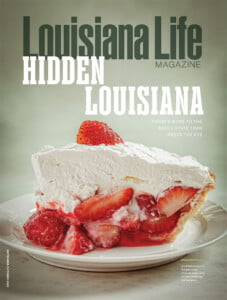Ruston Artist Nicole Duet and the Confluence of Art and Life

Windowsill
“Those who can, do; those who can’t, teach.” This snarky line from a 1905 play by George Bernard Shaw certainly doesn’t apply to artist Nicole Duet, an award-winning painter and long-time art professor at Louisiana Tech in Ruston, Louisiana.
Early in life, the New Orleans-born Duet dreamt of being an actor or perhaps a singer or writer. With that in mind, she studied theater at LSU and later at the University of New Orleans, where she had a part in Sam Shepard’s play “Fool for Love.” That was it. Duet was off to study acting at California State University Northridge. While there, she took an elective course in figure drawing. It changed her life. The moment came while sketching an older man.
“There was something poignant about the effort he took to step off the stand and grab a robe,” she says. “Looking back, I think it was a breakthrough in my own awareness, and the beginning of my love of drawing and painting. I realized that I could channel the very same love of exploring the dynamics of human nature that theater provided but through drawing and painting the figure.”

Encounter with Rachel Ruysch
With her career now heading in a new direction, Duet earned a Master of Fine Arts in drawing and painting at Cal State Long Beach. After a brief time teaching art at colleges in the Los Angeles area, Duet headed back to Louisiana in 2011 to accept a faculty position at Louisiana Tech, where she now serves as chair of the studio art program and holds the impressive Louisiana Board of Regents’ Elva Leggett Smith Professorship in Liberal Arts.
On the art side of her parallel career, Duet’s paintings have appeared in juried exhibits from California to New York. She also has received numerous commissions and her work can be found in public and private collections in California and Louisiana.

Crystal Balls
Yet with all the career roads she has traveled, her early interest in theater is often evident in her paintings. Her softly focused and often faceless scenes resemble paused theatrical moments in a stage play or movie just before action resumes. As to style, she describes her approach to painting as “rooted in realism but also liberated from it.” Whether terms such as expressionistic, impressionistic, liberated realism or narrative figurative are used to describe her images, they are about stories, often everyday life stories. They draw viewers in, wanting to know more.
“It relates to the way narratives unfold in literature,” she says. “I’m a reader, and literature continues to be a big influence. Someone once said to me that great novels unfold like great paintings and great paintings read like great novels, and that’s a very formative idea for me. I want my work to have resonance the way poetry does.”

True North
In her series “Ghost Cycles,” for example, Duet had just returned to Louisiana in 2011 and attended Mardi Gras in New Orleans for the first time in decades. While jostling among the crowds, she felt like a “tourist in my own hometown.” That experience triggered paintings that responded to how she felt “new and familiar” with the place she called home. It included dinner scenes with family and friends and shrines memorializing cyclists killed in accidents along New Orleans city streets.
A more recent shift in her work has produced what she describes as “smaller, more intimate and personal” and “less literal.” She says they are more reflective “metaphors” for what she observes. In this new work, she continues, the “composition is the story.” Her painting “Song of the Sea,” for instance, is about her aging father and her deep roots in New Orleans and the South.
“He is 89 now,” says Duet, “and the more we see signs of age the more poignant my awareness of the temporary nature of things is, and while in some ways the painting is about loss or the expectation of loss, it’s also about the fullness of life. Everything I’ve done since taking this position at Tech, my heritage as a New Orleanian is a core part of who I am as an artist. I want that aspect to be resonant and visible in the work but not the sole expression of the work. I believe in the voices of the South, in the richness of narrative in the South, and all their complexity, longing, beauty, tenderness and contradiction.”

Pirate’s Alley
How does Duet hope viewers respond to her work? “There are ways that painting touches the internal life of a viewer through sensation,” she says. And those sensations, she continues, open “the emotion and intellect.”
She recalls her first visit to the Getty Museum in Los Angeles and how it affected her. Exiting the museum, she found “the trees, the color of the sky, the textures or appearance of everything around me was heightened.” Painting, she says, has helped her see people, places and experiences of day-to-day life “in a different way.”
Indeed, Duet shows us how to truly see moments as stories in our own lives. nicoleduet.net
Exhibits
Cajun | Prairie Stories: Art and Ecological Restoration on Louisiana Prairies.
Influence of Louisiana’s prairies in local visual culture, through May 10. Acadiana Center for the Arts, Lafayette. acadianacenterforthearts.org
Central | The River is the Road: Paintings by George Rodrigue.
Rodrigue’s use of the river as a metaphor for his Cajun heritage, March 7 through June 21. Alexandria Museum of Art. themuseum.org
Plantation | In a New Light: American Impressionism 1870-1940.
Survey of American Impressionism, through March 23. LSU Museum of Art, Baton Rouge. lsumoa.org
NOLA | Hoa Tay (Flower Hands).
Features Southern artists of the Vietnamese diaspora. March 15 through Sept. 21. Ogden Museum of Southern Art, New Orleans. ogdenmuseum.org
North | “Annual Juried Competition.”
Showcases contemporary artists throughout the U.S., through May 3. Masur Museum of Art, Monroe. masurmuseum.org
